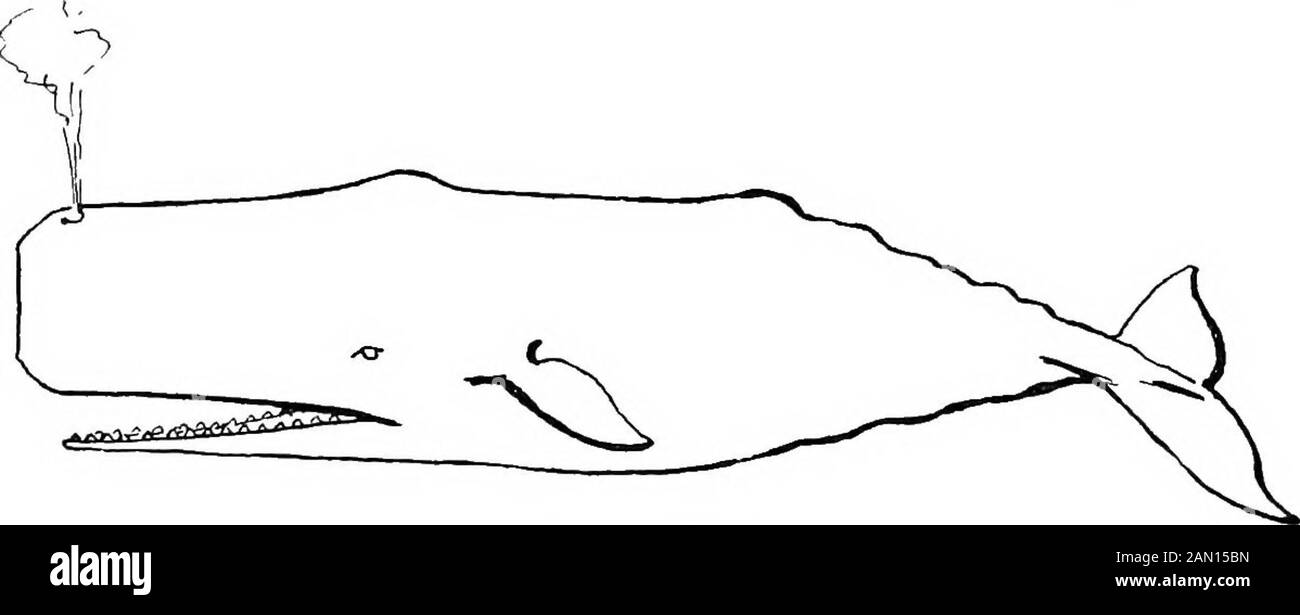California mammals . onal Museum, thinksit is doubtful if this Whale is distinct from Balxnoptera physalus. 26 CALIFORNIA MAMMALS. Suborder Denticete (Tooth—Whale.)Teeth nearly always present in the lower jaw and often inthe upiper; no baleen; rami of lower jaw united by a symphysealsuture; olfactory organ rudimentary or absent; nostrils combin-ing in one spiracle. Family Physeteridae. (The Sperm Whale.)Lower jaw slender and set with teeth, usually numerous,sometimes few; upper jaw large and toothless; head large; costalcartileges not ossified; skull usually unsymmetrical. Subfamily Physeterin

Image details
Contributor:
The Reading Room / Alamy Stock PhotoImage ID:
2AN15BNFile size:
7.2 MB (100.2 KB Compressed download)Releases:
Model - no | Property - noDo I need a release?Dimensions:
2487 x 1005 px | 21.1 x 8.5 cm | 8.3 x 3.4 inches | 300dpiMore information:
This image is a public domain image, which means either that copyright has expired in the image or the copyright holder has waived their copyright. Alamy charges you a fee for access to the high resolution copy of the image.
This image could have imperfections as it’s either historical or reportage.
California mammals . onal Museum, thinksit is doubtful if this Whale is distinct from Balxnoptera physalus. 26 CALIFORNIA MAMMALS. Suborder Denticete (Tooth—Whale.)Teeth nearly always present in the lower jaw and often inthe upiper; no baleen; rami of lower jaw united by a symphysealsuture; olfactory organ rudimentary or absent; nostrils combin-ing in one spiracle. Family Physeteridae. (The Sperm Whale.)Lower jaw slender and set with teeth, usually numerous, sometimes few; upper jaw large and toothless; head large; costalcartileges not ossified; skull usually unsymmetrical. Subfamily Physeterinae. Lower jaw with numerous teeth, which are held in a longgroove by a strong fibrous gum-like substance; upper part ofcranium quite unsymmetrical through atrophism of the rightnostril. Two genera, each with one living species. They preferwarm waters and are found in all open seas except the Arctic andAntarctic Oceans, The food is squid, cuttlefish, octopus, etc.Sperm Miales are much less common now that formerly.. Sperm Whale. Gemis Physeter Linneus. (To blow.)Dorsal fin obsolete; pectoral fin short, broad; head long anddeep, squarish in front, with a large internal cavity filled withoil; teeth 40 to 50; vertebrc-e 50; most of the cervical vertebraunited. PHYSETERID^ 27 Physeter macrocephalus Linn. (Great—head.) SPERM WHALE. Blackish above; lighter below, particularly on the breast. Length of adult male from 70 to 85 feet; females muchsmaller. Found in nearly all seas from 56 degrees north latitude to50 degrees south. This, the largest of the toothed cetaceans, is known to Eng-lish and Amercan whalemen as the Sperm Whale, to the Germansas the Pottfish, and to the French as the Cachelot. It widelydiffers from all others of the order, both in figure and habits.The fully matured animal equals, if it does not exceed, the Bow-head in magnitude and in commercial value. The adult female, however, is only about one-third or one-fourth of the size of thelargest male. She is likewis